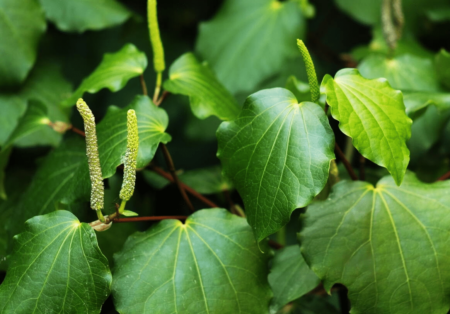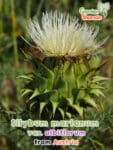- What is Kawakawa
- Botanical properties
- Distribution and habitat
- Traditional applications
- Modern research and applications
- Cultivation and conservation
- Conclusion
1 What is Kawakawa?
Kawakawa, or scientifically known as Piper excelsum and Macropiper excelsum, is a small tree native to New Zealand, traditionally prized by the Māori for its bitter taste [2]. This versatile plant, often referred to as "Māori Kava", belongs to the pepper family and shares a distant relationship with kava (Piper methysticum), a drink prized in the Pacific region for its relaxing properties [1][2]. The relationship between Macropiper and Piper is often distinguished as subtle, which makes the cultural and botanical significance of these plants specific [1].
In addition to its traditional use in Māori culture, kawakawa has attracted scientific interest due to its potential health benefits, which range from alleviating psoriasis to promoting general health [1][2]. The terms kava, kawakawa, Piper excelsumTahitian pepper and Maori kava all play a role in the rich botanical and cultural history of this plant. This article provides an in-depth look at the botanical properties of kawakawa, its distribution and habitats, traditional uses and modern research findings, and methods for its cultivation and conservation.
2. botanical properties
- Leaf characteristics:
- Kawakawa leaves are large, dark green, shiny and heart-shaped, with a width of up to 120 mm. They have radiant veins from the center and a peppery taste, often with insect holes [1].
- The leaves of the kawakawa tree are often covered with holes caused by the caterpillar feeding of the kawakawa looping moth [2].
- Piper excelsum leaves are arranged opposite each other, long-stalked, up to 12 cm long, aromatically fragrant, heart-shaped, glossy dark green on top with pronounced veins [1].
- Flowers and fruits:
- The flowers appear on greenish, upright spikes that are 2.5-7.5 cm long [2].
- After pollination, the flowers gradually swell and become fleshy to form small, berry-like fruits that range in color from yellow to bright orange [2].
- The sweet, edible yellow berries of the plant were consumed as a diuretic [2].
- Growth and classification:
- Piper excelsum is an evergreen, densely leafy, multi-stemmed shrub or small tree that can grow up to 6 meters high [9].
- Macropiper latifolium grows up to 50cm-100cm tall and is a member of the Piperaceae family, known as "false kava" due to its similarity to Piper methysticum [8] [10].
- The plant has a chromosome number of 2n = 26 and is not classified as threatened according to the New Zealand Threat Classification System of 2017 [1].
3. distribution and habitat
- Original habitat and distribution:
- Piper excelsum and Macropiper latifolium are originally native to New Zealand, with their distribution extending across the North and South Islands. They are distributed from te Paki in the north to around Okarito, North Canterbury and Banks Peninsula in the south [1][2].
- These species prefer coastal to lowland habitats and are often found as important understory species in coastal forests [1]. Its preference for a warm, temperate climate makes it particularly suitable for coastal locations [7].
- Global adaptability:
- Protection status and conservation:
- Despite their widespread distribution and adaptability Piper excelsum Not classified as threatened since 2017, which emphasizes their stability in their natural habitat and under cultivation conditions [1]. The species Macropiper latifolium also enjoys a protected status as "Not Endangered", which ensures its sustainable presence in its natural habitats [10].
4. traditional applications
- Healing applications:
- Kawakawa leaves were traditionally used as poultices to treat bruises and served as a sign of mourning [1][2]. This practice illustrates the deep cultural significance of kawakawa in Māori society.
- An infusion of the leaves or roots of Kawakawa has been made and used for bladder problems, boils, bruises, to relieve pain or toothache and as a general tonic [2]. This shows the versatility of kawakawa in traditional Māori medicine.
- On official occasions such as a tangi (mourning ceremony), both hosts and guests wore wreaths of kawakawa leaves on their heads as a sign of mourning [2]. This custom illustrates the symbolic significance of kawakawa in Māori ritual practices.
- Cultural practices:
- The sweet, edible yellow berries of the plant were consumed as a diuretic [2]which indicates a use of the plant beyond its medicinal properties.
- Kawakawa is sometimes referred to as "Māori Kava" and has often been confused with the kava plant (Piper methysticum), although they are different, albeit related, species [2]. This confusion underlines the cultural connection between the plants in the Pacific region.
- Ritual use:
- The persecution of the Tohungas (Māori healers or shamans) in 1907 led to a lack of information about how Māori ritually used their indigenous kava kava [15]. Despite these historical challenges, Kawakawa remains an integral part of Māori culture and tradition.
5. modern research and applications
Modern research and applications of kawakawa and kava show a wide range of health benefits and chemical properties:
- Health benefits and chemical composition of kawakawa:
- Analysis of chemical profiles of kawakawa leaves by LC-MS/MS identified 64 compounds, including phenylpropanoids, lignans, flavonoids, alkaloids and amides [17].
- The chemical composition varies significantly depending on the source of the leaves, with commercially available sources having higher concentrations of phenylpropanoids and flavonoids compared to freshly collected samples [17].
- The concentrations of pharmacologically active metabolites absorbed from kawakawa are far below the documented toxicity thresholds [17].
- Health benefits and risks of kava:
- Kavalactone from the kava plant have anxiolytic, analgesic and antioxidant properties [3].
- Kava consumption leads to relaxation, reduced anxiety, a mild feeling of euphoria and improved communication [3].
- Possible side effects and risks include liver damage and allergic reactions. Due to potential risks, people with liver disease, pregnant or breastfeeding women and those taking certain medications should avoid kava [4].
These findings emphasize the importance of further research and development to unlock the full potential of kawakawa and kava in modern medicine and therapy while ensuring their safety.
6. cultivation and conservation
The cultivation and preservation of Piper excelsum and Macropiper latifolium is crucial for the conservation of these unique plant species. Here are some important aspects and steps to consider when cultivating and conserving them:
- Cultivation:
- Piper excelsum and Macropiper latifolium can easily be grown from semi-hardy cuttings and fresh seeds [1][11].
- For sowing, the seeds of Piper excelsum first be soaked in lukewarm water for about 24 hours [1].
- The seeds should be stored in moist substrate at 2-5°C for 4-6 weeks in the refrigerator or in a cold house before planting [1].
- The optimum planting temperature is around 20-23°C in a bright and constantly moist, but not wet, location [1].
- Care instructions:
- Piper excelsum is very shade-tolerant, but sensitive to cold and does not tolerate frost [1].
- The plant should be watered regularly during the growing season and fertilized every 2 weeks with a 0.21TP3 solution or slow-release fertilizer [1].
- Overwintering should take place at a minimum temperature of 5-10°C, watering only enough to prevent the root ball from drying out completely [1].
- Conservation:
- The conservation status of Piper excelsum subsp. excelsum is classified as "Not threatened" (2017) [1].
- Due to the widespread cultivation of Ginkgo biloba its conservation and accessibility has been improved, while conservation efforts aim to protect the remaining wild populations [1]. These strategies can serve as a model for the conservation of Piper excelsum and Macropiper latifolium serve.
7 Conclusion
Through a comprehensive discussion of botanical characteristics, traditional uses and modern research findings to cultivation and conservation approaches, this article has highlighted the cultural and scientific significance of kawakawa. The in-depth understanding of this plant, its multiple health benefits and the cultural significance for the Māori illustrate the need to ensure their conservation and sustainable use. The research findings presented also underline the potential for further scientific studies that could expand the application possibilities of kawakawa in modern medicine.
In conclusion, kawakawa is more than just a traditional Māori plant. It symbolizes the link between tradition and modern science and is therefore a valuable heritage that needs to be protected and promoted. Future research and increased awareness of the importance of this plant can not only help preserve its biodiversity, but also strengthen its role as a bridge between past generations and modern society. The findings and recognition of the traditional and modern importance of Kawakawa impressively demonstrate the importance of preserving indigenous knowledge and practices and making them accessible to future generations.
Further links
- https://en.wikipedia.org/wiki/Piper_excelsum
- https://www.nzpcn.org.nz/flora/species/piper-excelsum-subsp-excelsum/
- https://www.canarius.com/de/pflanzen/macropiper-latifolium.html
- https://powo.science.kew.org/taxon/urn:lsid:ipni.org:names:677743-1
YouTube
Note: The information in this article is for informational purposes only and is not intended to replace the advice of a physician or other healthcare professional. Always consult a doctor before using any new herbs or supplements. Furthermore, you should always check whether the cultivation/possession/use/processing of certain plants is permitted in your country. As we only offer ornamental plants in our store, we are only allowed to offer Provide information and advice on the correct care of plants!
References
[1] – https://www.nzpcn.org.nz/flora/species/piper-excelsum-subsp-excelsum/
[2] – https://en.wikipedia.org/wiki/Piper_excelsum
[3] – https://www.chemie.de/lexikon/Kava.html
[4] – https://krank.de/behandlung/heilpflanzen/kava/
[5] – https://flexikon.doccheck.com/de/Kava-Kava
[6] – https://de.wikipedia.org/wiki/Kava
[7] – https://www.rarepalmseeds.com/de/piper-excelsum-de
[8] – https://www.canarius.com/de/pflanzen/macropiper-latifolium.html
[9] – https://www.sunshine-seeds.de/Macropiper-excelsum-34360p.html
[10] – https://www.gbif.org/species/7305271
[11] – https://www.nzpcn.org.nz/flora/species/piper-excelsum-subsp-peltatum/
[12] – https://arzneipflanzenlexikon.info/kava-kava.php
[13] – https://eol.org/tr/pages/52563246/articles
[14] – https://www.asklepios-seeds.de/macropiper-excelsum-samen-maori-kawa-kava-kava-tahiti-pfeffer.html
[15] – http://entheology.com/research/macropiper-excelsum-maori-kava/
[16] – https://www.highvaluenutrition.co.nz/2023/12/18/whats-in-a-name/
[17] – https://www.ncbi.nlm.nih.gov/pmc/articles/PMC9741024/
[18] – https://www.temarareo.org/PPN-Kava.html












